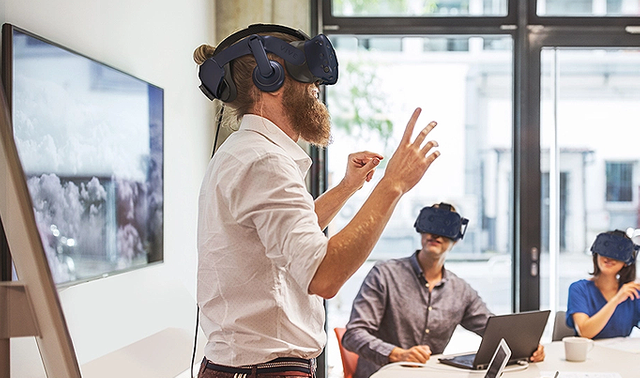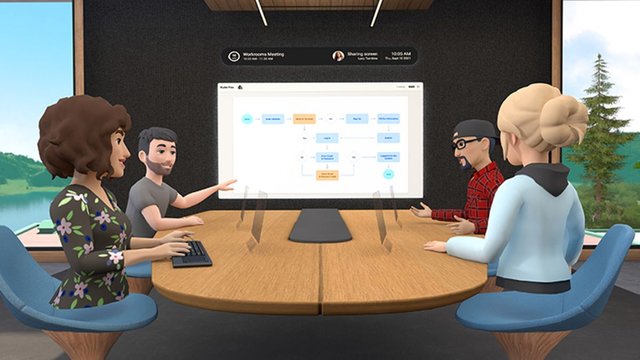Metaverse is a mixed reality made up of a combination of technologies and trends like AR, head-mounted displays (HMDs), the Internet of Things (IoT), an augmented reality (AR) cloud, artificial intelligence (AI) and spatial technologies; a persistent, immersive digital environment. An environment of independent, yet interconnected networks that will run on some protocols for communications. This environment enables persistent, decentralized, collaborative, interoperable digital content that intersects with the physical world’s real-time, spatially oriented and indexed content.
These together will give rise to new technologies and trends, to form a complete metaverse solution.
The demands from the metaverse would be to generate virtual spaces on-demand for a global audience which would need the help of AI to scale. Just the way Meta CEO launched Builder Bot; another technology that he thinks will be crucial to the company’s vision of creating an immersive environment. This voice bot allows users to change their virtual surroundings with voice commands. An early version of the concept, called Builder Bot, was displayed at a virtual event detailing Meta’s latest AI research. Conversational AI has a huge role to play in the metaverse.
The metaverse is about the inescapable dematerialization of physical space, distance, and objects, which includes 3D games like Fortnite on our game consoles, Beat Saber in our VR headsets, and Roblox on our computers. It also includes Alexa in our kitchen, Zoom in our virtual offices, Clubhouse on our phones, and Peloton in our home gyms. What happens when physical space is dematerialized? What was once scarce may become abundant. In a game, you can dream of being a rock star, a soldier, a race car driver, or anything you might imagine. Imagine what happens when you apply this to known situations. For example, a product launch event in physical space can sell only a few seats in the front row — but a virtual event can create a personalized plane of existence around each individual in which you always enjoy the best seat in the house. In physical world interactions, the metaverse will supply real-time, interesting, actionable information across scenarios.
Before we dig into about roles of the metaverse, I would like to present an upcoming event Envision the Future of Businesses in Metaverse. Where you know about the Metaverse will really be instrumental in shaping our lives; from being buyers to enablers, or is it just a fad. Join this virtual event on 12 April 2022
Here’s how conversational AI can play a big role in the Metaverse, especially for brands.
Interactive retail and commerce
With the help of AI and metaverse technology, interactive experiences such as a demonstration in the biology lab, a museum or a performance park are possible. For example, the instructor can log in and perform the demonstration for people who are located miles away because of the metaverse technology. Similarly, the demonstration can also be used for upselling and cross-selling. Retail can extend its reach to an immersive shopping experience that allows for more complex products that have been a challenge on mobile device applications. Business leaders, especially in the consumer products/services space, should be solidifying plans for “virtualizing” (tokenizing) their artifacts. They should also begin exploring how their enterprises might participate in future digital realms, even if they are only extensions of current e-commerce efforts.
Industrial training and repair
Logistics can be an expensive affair especially when enterprises are trying to meet margins by cutting costs where necessary. When it comes to highly niche arenas such as airplane craftship or the rig machineries that are the size of buildings, damages need a lot of resources to replace the works. In order to get the situation up to scale again, conversational AI can take on the task of training new people and helping with one-off repairs that would otherwise need human experts sourced in. People can save their time that would otherwise be spent on teaching new employees. Real world conversational AI examples are already taking off across the globe.

Wayfinding
Whether you’re creating wayfinding for a stadium, school, department store or theme park, there are some core wayfinding principles that must be considered in order for visitors to navigate themselves along the customer journey. The value of an effective wayfinding system is not only determined by a positive visitor experience, but by how you maximize on the customer’s route and dwell time. Conversational AI can turn this entire experience into a strategic route making and creating a wayfinding ‘story’ which ensures that visitors are informed of what products/attractions/facilities are available and potentially increase revenue.
Education
Imagine “teleporting” from an office meeting into a social gathering, into a history class or into an underwater tour — within any given interface/application. Although current metaverse experiences will not completely replace current digital interactions via apps, websites and so forth, it is likely to pave the way to new types of interactions and business models to optimize on these new use cases. This can result in interactive learning. Education will be greatly enhanced when we can change the environment anytime to anything.

Virtual Events and Experiences
Virtual events or experiences have gained a lot of popularity over the last 18 months. Today, we can extend more collaborative and immersive offerings to virtual events. If a company is performing an event tour at 10 different locations at the same time, conversational AI can help scale the experience with the help of a voice bot. Gamification in all ventures of the metaverse are likely to increase and to help scale such systems, AI can prove effective. '